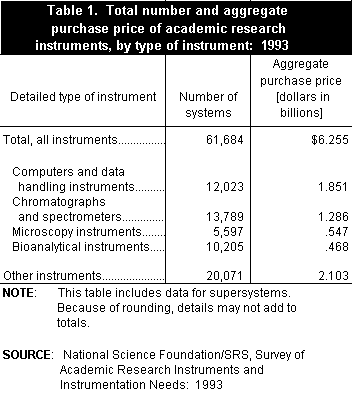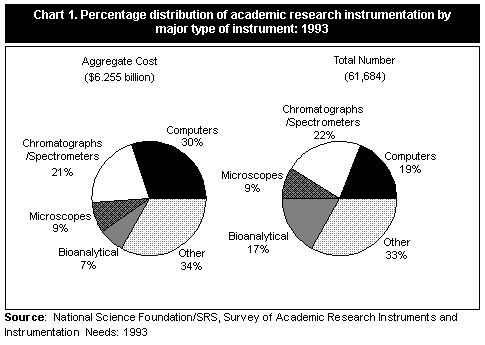|
 |
Average Age of Research Instruments
Overall, about 4 of every 10 research instrument
systems in use in 1993 had been acquired within the previous 4
years. On the other hand, almost one quarter (23 percent) of
the instruments in active research use in 1993 were over 8 years
old. The average age of a research instrument was 5.8 years.
Seventeen percent of all instruments costing less than $1 million
were less than 2 years old in 1993, but only 7 percent of instruments
over $1 million were that new.
Functional usage of research instruments
Sixty-four percent of the instruments in research
usage in 1993 were used exclusively for research.
Most of the remaining instruments (32 percent) were utilized
predominantly for research with some instructional use. Only
4 percent of the total were used primarily for instruction
with some research usage.
Average number of users of research instruments
In 1993, there was an average of 24.2 users per instrument
system. The largest single category of user— an average of 8.5
per instrument— was the graduate students and postdoctorates assigned
to the same unit that owned the instrument (host unit). On average,
there were also 3.5 faculty users from the host unit, 6.0 researchers
from other units in the host institution, 4.5 researchers from
outside the host institution, and 1.8 other users (primarily staff
and undergraduates). State-of-the-art instruments were used at
about the same rate as all instruments combined: there was an
average of 25.7 users of state-of-the-art instruments and 24.2
users for all instruments, not a statistically significant difference.
Description of the 1993 Survey
In 1993, there were 318 colleges, universities, and
medical schools in the U.S. with total R&D expenditures at
or above $3 million; there were about 1,541 in-scope S&E departments
and research facilities (units) at these institutions. The 1993
Instrumentation Survey covered the research instruments in these
units which had an original purchase price of $20,000 or more
and were in the following science and engineering (S&E) fields:
agriculture, biology, computer science, environmental sciences,
chemistry, physics/astronomy, and engineering.[2]
The survey excluded research instruments assigned to any of the
university-administered Federally Funded Research and Development
Centers (FFRDCs), as well as any assigned to laboratories that
might be housed on a university campus but not administered by
the university.
The Instrument Survey had two questionnaires and
two sets of respondents:
- Principal investigators completed an Instrument
Data Sheet in which they provided detailed data about individual
pieces of research instruments. This Data Brief summarizes the
findings from this questionnaire. More detailed data may be found
in the forthcoming NSF publication, Characteristics of Science
and Engineering Instrumentation in Academic Settings: 1993.
- The heads of academic departments and research
facilities completed a Department/Facility Questionnaire
in which they provided 1993 expenditure data for purchasing, maintaining,
and operating their instruments, as well as an evaluation of their
overall instrumentation and future needs. Data from this questionnaire
are published in the companion NSF report, Academic Research
Instruments: Expenditures-1993, Needs-1994 (NSF 96-324).
This Data Brief was prepared by:
Carolyn B. Arena
National Science Foundation
Division of Science Resources Studies
4201 Wilson Boulevard, Suite 965
Arlington, VA 22230.
For free copies of SRS Data Briefs, write to the
above address, call 703-306-1774, or
e-mail to pubs@nsf.gov. |


 [1]
Status information could not be collected for approximately 155 "supersystems," which were specialized, integrated instruments that were essentially synonymous with the administering unit itself. Totaling $1.171 billion in aggregate cost, these 155
supersystems represented less than 1 percent of the total numbers of research instruments over $20,000 and 19 percent of the aggregate cost of the total inventory. Therefore, although the aggregate stock information above does include these
"supersystems," the status information in this Data Brief pertains only to non-"supersystems"-approximately 61,529 research instruments with a total aggregate purchase price of $5.083 billion.
[1]
Status information could not be collected for approximately 155 "supersystems," which were specialized, integrated instruments that were essentially synonymous with the administering unit itself. Totaling $1.171 billion in aggregate cost, these 155
supersystems represented less than 1 percent of the total numbers of research instruments over $20,000 and 19 percent of the aggregate cost of the total inventory. Therefore, although the aggregate stock information above does include these
"supersystems," the status information in this Data Brief pertains only to non-"supersystems"-approximately 61,529 research instruments with a total aggregate purchase price of $5.083 billion.

